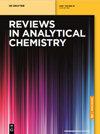亚洲水稻品种挥发性芳香族化合物的提取、鉴定、定量及应用
IF 3.8
3区 化学
Q2 CHEMISTRY, ANALYTICAL
引用次数: 10
摘要
亚洲占世界一半以上人口的主要食物是水稻,仅次于小麦。除了碳水化合物来源外,由于含有芳香化合物,通过降低血糖指数和丰富的膳食纤维对健康有益,因此大米在功能性食品方面获得了极大的兴趣。香米特别是印度香米的需求在当地和全球市场不断扩大,因为香味被消费者认为是最好的品质和理想的特征。由于芳香烃、醛类、酚类、醇类、酮类和酯类的存在,在煮熟的香米中有500多种挥发性芳香族化合物(VACs)保证了优异的香气和风味。产生香气的主要VAC是2乙酰基-1-吡咯啉,它通常存在于作物的地上部分,并在种子成熟期间沉积。迄今为止,有关水稻中芳香族化合物的文献报道较多,但对芳香族化合物的提取、表征和定量分析技术研究较少。因此,本文对芳香族化合物的提取、表征及应用进行了综述。这些VACs作为生物香料和生物香气化合物,可以提高饮料、食品和发酵产品(如无麸质米面包)的附加值,为食品加工和饮料工业提供新的途径。此外,由于其营养价值,这些VACs可用于生物强化,最终解决粮食营养安全问题。本文章由计算机程序翻译,如有差异,请以英文原文为准。
Extraction, characterization, quantification, and application of volatile aromatic compounds from Asian rice cultivars
Abstract Rice is the main staple food after wheat for more than half of the world’s population in Asia. Apart from carbohydrate source, rice is gaining significant interest in terms of functional foods owing to the presence of aromatic compounds that impart health benefits by lowering glycemic index and rich availability of dietary fibers. The demand for aromatic rice especially basmati rice is expanding in local and global markets as aroma is considered as the best quality and desirable trait among consumers. There are more than 500 volatile aromatic compounds (VACs) vouched for excellent aroma and flavor in cooked aromatic rice due to the presence of aromatic hydrocarbons, aldehydes, phenols, alcohols, ketones, and esters. The predominant VAC contributing to aroma is 2 acetyl-1-pyrroline, which is commonly found in aerial parts of the crop and deposits during seed maturation. So far, literature has been focused on reporting about aromatic compounds in rice but its extraction, characterization, and quantification using analytical techniques are limited. Hence, in the present review, extraction, characterization, and application of aromatic compound have been elucidated. These VACs can give a new way to food processing and beverage industry as bioflavor and bioaroma compounds that enhance value addition of beverages, food, and fermented products such as gluten-free rice breads. Furthermore, owing to their nutritional values these VACs can be used in biofortification that ultimately addresses the food nutrition security.
求助全文
通过发布文献求助,成功后即可免费获取论文全文。
去求助
来源期刊

Reviews in Analytical Chemistry
化学-分析化学
CiteScore
7.50
自引率
0.00%
发文量
15
审稿时长
>12 weeks
期刊介绍:
Reviews in Analytical Chemistry publishes authoritative reviews by leading experts in the dynamic field of chemical analysis. The subjects can encompass all branches of modern analytical chemistry such as spectroscopy, chromatography, mass spectrometry, electrochemistry and trace analysis and their applications to areas such as environmental control, pharmaceutical industry, automation and other relevant areas. Review articles bring the expert up to date in a concise manner and provide researchers an overview of new techniques and methods.
 求助内容:
求助内容: 应助结果提醒方式:
应助结果提醒方式:


